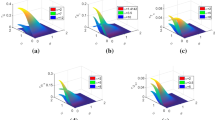Abstract
We extend the matrix decomposition method (MDM) in classifying the 2 × N × N truly entangled states to 2 × M × N system under the condition of stochastic local operations and classical communication. It is found that the MDM is quite practical and convenient in operation for the asymmetrical tripartite states, and an explicit example of the classification of 2 × 6 × 7 quantum system is presented.
Similar content being viewed by others
Explore related subjects
Discover the latest articles, news and stories from top researchers in related subjects.References
Einstein A., Podolsky B., Rosen N.: Can quantum-mechanical description of physical reality be considered complete?. Phys. Rev. 47, 777 (1935)
Bell J.S.: On the Einstein Podolsky Rosen paradox. Physics 1, 195 (1964)
Ekert A.K.: Quantum cryptography based on Bell’s theorem. Phys. Rev. Lett. 67, 661 (1991)
Bennett C.H., Bessette F., Grassard G., Salvail L., Smolin J.: Experimental quantum cryptography. J. Cryptol. 5, 3 (1992)
Bennett C.H., Wiesner S.J.: Communication via one- and two-particle operators on Einstein–Podolsky–Rosen states. Phys. Rev. Lett. 69, 2881 (1992)
Mattle K., Weinfurter H., Kwiat P.G., Zeilinger A.: Dense Coding in Experimental Quantum Communication. Phys. Rev. Lett. 76, 4656 (1996)
Nielsen M.A., Chuang I.L.: Quantum Computation and Quantum Information. Cambridge University Press, Cambridge (2000)
Horodecki R., Horodecki P., Horodecki M., Horodecki K.: Quantum entanglement. Rev. Mod. Phys 81, 865 (2009)
Dür W., Vidal G., Cirac J.I.: Three qubits can be entangled in two inequivalent ways. Phys. Rev. A 62, 062314 (2000)
Chen L., Chen Y.-X., Mei Y.-X.: Classification of multipartite entanglement containing infinitely many kinds of states. Phys. Rev. A 74, 052331 (2006)
Cheng S., Li J., Qiao C.-F.: Classification of the entangled states of 2 × N × N. J. Phys. A 43, 055303 (2010)
Chen L., Chen Y.-X.: Range criterion and classification of true entanglement in a 2 × M × N system. Phys. Rev. A 73, 052310 (2006)
Cornelio M.F., de Toledo Piza A.F.R.: Classification of tripartite entanglement with one qubit. Phys. Rev. A 73, 032314 (2006)
Horn R.A., Johnson C.R.: Matrix Analysis. Cambridge University, Cambridge (1985)
Cheng, S., Li, J., Qiao, C.-F.: Classification of the entangled state of 2 × 5 × 5 pure systems. J. Grad. Sch. Chin. Acad. Sci. 3, 303 (2009) (in chinese).
Author information
Authors and Affiliations
Corresponding author
Rights and permissions
About this article
Cite this article
Li, JL., Qiao, CF. Classification of the entangled states 2 × M × N . Quantum Inf Process 12, 251–268 (2013). https://doi.org/10.1007/s11128-012-0370-2
Received:
Accepted:
Published:
Issue Date:
DOI: https://doi.org/10.1007/s11128-012-0370-2




